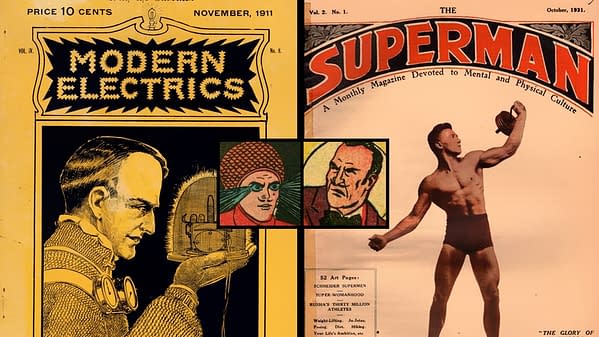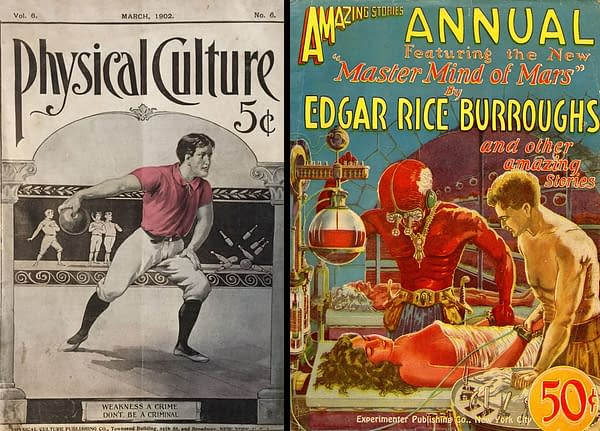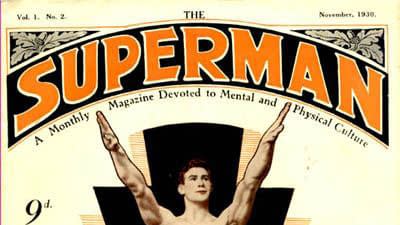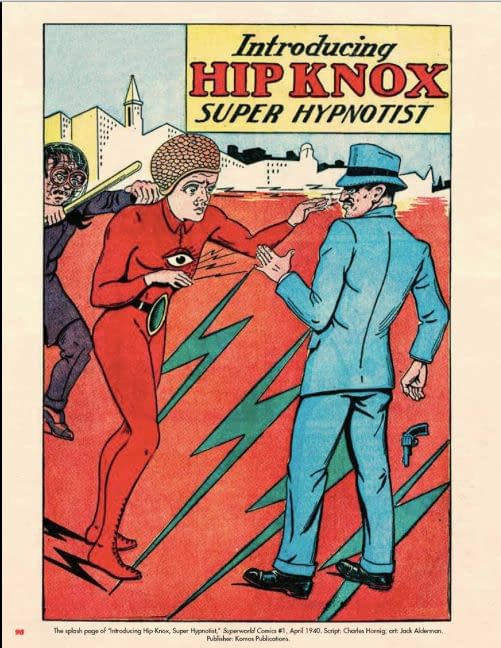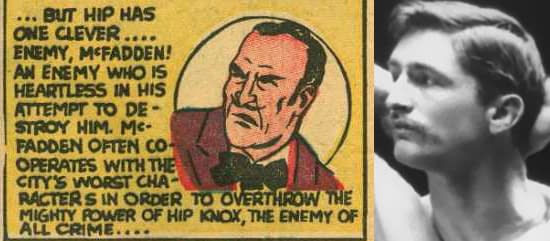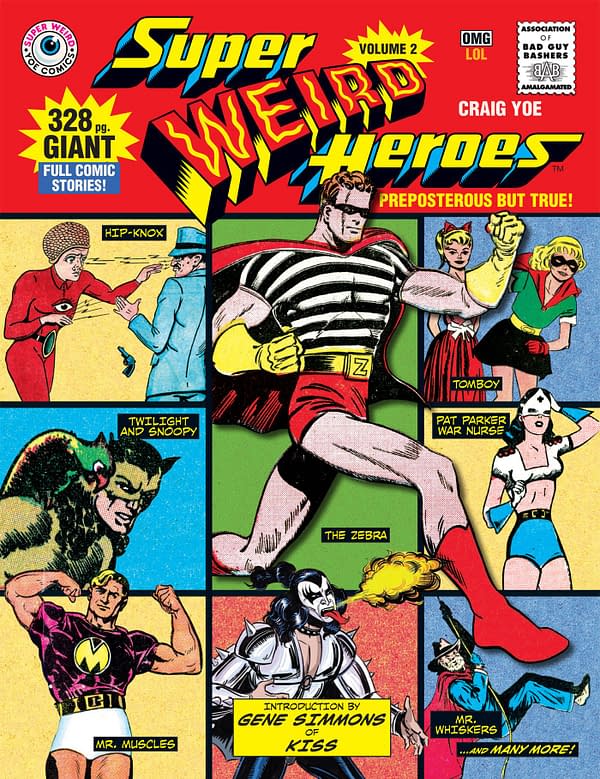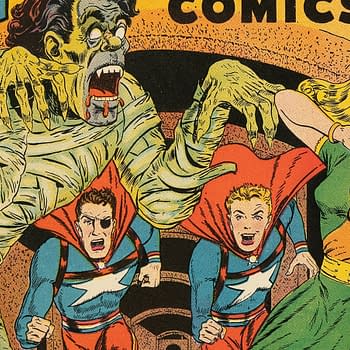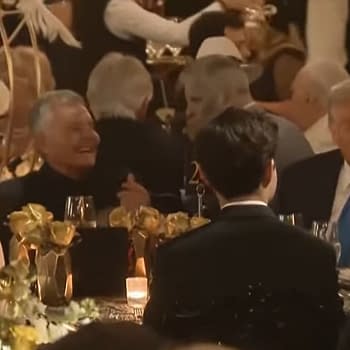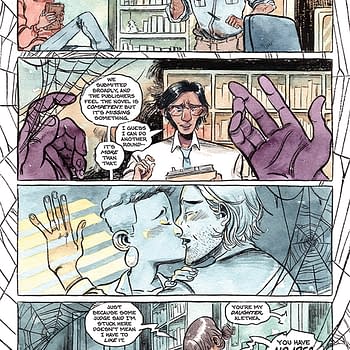Posted in: Comics, Comics History | Tagged: bernarr macfadden, Craig Yoe, hugo gernsback
Super Weird Heroes v2.3: Who Will Be The Man of Tomorrow?
A completely bizarre tale of Hugo Gernsback vs Bernarr Macfadden in Gernsback's Superworld Comics.
The Hip Knox story that Craig Yoe has chosen for inclusion in his Super Weird Heroes Volume 2 is one of my favorite weird tales in this book, but not just for the story itself. Oh, the story is certainly quite weird, and the character is very weird indeed, but the thing that makes this comic truly great is the way that it can all be unpacked into… I don't even know how to put it… sort of a weird history that time forgot.
Yoe sets up the tale by astutely pointing out that this is in large measure about Hugo Gernsback vs Bernarr Macfadden. This fact alone can be expanded into whole new dimensions of weird history that is little understood, but that's what this companion series of posts is all about, so here we go:
History tells us that Hugo Gernsback created and/or first used the term "science fiction". This is not true. It's often said that he launched the first letter columns and instigated the first organized fandom. This is also untrue, as there are many thousands of prior examples of letter columns in periodical fiction publications, and of editors interacting with fans in those columns, and of organized fan clubs spinning out of those publications. He's been called the father of Science Fiction, which might charitably be called a stretch, and ignores a very steady stream of great science fiction from the 1880s through the 1910s and before, including Jules Verne, HG Wells, Luis Senarens, Arthur Conan Doyle, H. Rider Haggard, Weldon J. Cobb, and others.
Despite this, Gernsback should still be held in high regard in context of the history of science fiction. Why is Gernsback important? To paraphrase Everett F. Bleiler in Science Fiction: The Gernsback Years, he did turn that stream of science fiction into an actual section of science fiction on the newsstand, which is no small thing. He was an enthusiastic promoter of the genre, he understood how to connect with fandom, and perhaps most importantly of all, he is largely responsible for planting the seeds of what we might today call the hacker or maker ethos. Publications like Radio News, Electrical Experimenter, Modern Electrics, along with an 'educational library' of how-to manuals on these topics encouraged young readers to learn, think, and make. My complaint about this history is not about Gernsback himself, but rather that these events are commonly interpreted as meaning there was no significant science fiction before him. That's very far from the truth.
If Gernsback built his empire on the power of science and imagination, then publisher Bernarr Macfadden largely built his own substantial publishing domain on the power of the body, literally. Macfadden was part of the leading wave of what was then called "physical culture" in America, which began in earnest in the final decade of the 19th century. If bodybuilder and performer Eugene Sandow helped spark the nation's initial fascination with physical culture — which is largely what we'd call health and fitness today — then Bernarr Macfadden would go on to become physical culture's standard bearer.
Just as Gernsback expanded from his original Modern Electrics publication, Macfadden parlayed the success of his Physical Culture magazine into a whole line of magazines, exercise and nutrition publications, bodybuilding gadgets, and similar endeavors. Macfadden expanded into fiction as well, with titles ranging from True Romances, Midnight, True Strange Stories, American Detective, and lots of others.
He also inspired lots of imitators, including a physical culture magazine title called The Superman, which began in the UK in 1930, well in advance of any version of Jerry Siegel and Joe Shuster's character of the same name (The Reign of the Superman in their fanzine Science Fiction is from 1933), and with some obvious general cultural similarities to the concept of the Man of Steel.
Eventually, Macfadden's expanding empire brought him into conflict with Gernsback. Gernsback's Experimenter Publications was pushed into bankruptcy in 1929, and Macfadden emerged as the owner of flagship science fiction pulp Amazing Stories in 1931. In a sense, it was perhaps a classic kind of conflict: brains vs brawn, jocks vs nerds (and note the "Weakness a crime, don't be a criminal" blurb on the early issue of Macfadden's Physical Culture shown above). Nothing less than the future of the future of mankind was at stake. Super brain power, or super strength? Who would be the Man of Tomorrow?
There are varying opinions among historians as to how this sequence of events played out, with historian Sam Moskowitz and some others claiming that Macfadden stage-managed events with other business interests which pushed Experimenter Publications into bankruptcy, and others simply noting that the record shows that Gernsback was perhaps a better editor and marketer than businessman.
Both Macfadden and a former employee of his turned in bids on the bankrupt Experimenter Publications assets, with the former employee, B.A. MacKinnon, winning the day. The eventual result was a web of financially-related companies which ultimately became the publishers of various former Gernsback titles, with familiar pulp-era names among the principles behind those companies, including Macfadden, Frank Armer and Harry Donenfeld.
It's that last name which gives us our best clue at what actually happened here, I think, because Harry Donenfeld — who would eventually become the owner of DC Comics — was well-known for fronting small publishers start-up money in exchange for equity and other assets. It was a common manuever in that era, employed by well-financed individuals in the field, who often had ties to printing or distribution.
Of course, Donenfeld is almost universally considered a scoundrel for a series of tactics which pushed DC Comics founder Malcolm Wheeler-Nicholson into bankruptcy, which allowed him to take control of the eventual publisher of Superman, Batman, and all the rest. The sequence of events has a familiar feel as compared to the Experimenter Publications matter, so it's very possible that Macfadden deserves a similar reputation in the eyes of history.
The Hip Knox story originally published in Gernsback's Superworld Comics #3 in 1940 does lend weight to the notion that Gernsback agreed with that assesment, and held a grudge against Macfadden nearly a decade after those events, regardless of any other details. As Craig Yoe notes, the villain of the Hip Knox story is named McFadden, and bears a general physical similarity to the real-life Bernarr Macfadden. The introductory captions set the scene:
Hip Knox is the greatest hypnotist in the world! He was brought up by a famous scientist who taught him how to use his mental powers to the greatest advantage…
…but Hip has one clever enemy, McFadden! An enemy who is heartless in his attempt to destroy him. McFadden often cooperates with the city's worst characters in order to overthrow the mighty power of Hip Knox, the enemy of all crime.
Put this all together with the little-known fact that Gernsback used a longstanding comedic pen-name Mohammed Ulysses Socrates Fips, and the Hip Knox vs McFadden face-off is very plausibly Gernsback vs Macfadden all over again. Brains vs brawn. Jocks vs nerds. And even if there are no financial records or court testimony of any particular machinations on Macfadden's part during Gernsback's 1929 bankruptcy to support Moskowitz's claims here, it would certainly seems that Gernsback held quite a grudge over the matter.
Fips was used as comic relief in scientific publications which were filled with diagrams, equations, and step by step unstructions. He was assigned duties that ranged from 'office boy' to editor, and often discussed his Indian heritage Given the similarity of "Fips" to "Hip", it may also be that the 'third eye' on Hip Knox's chest has its origin in Hindu and Buddhist third eye symbolism, because of the character of Mohammed Ulysses Socrates Fips that Gernsback had developed over the years.
As Yoe points out, Hip Knox's costume has a range of general precedents among Gernsback's prior publications, and to that I would add that just a few months before Superworld Comics #3 was published, no less a fashion authority than Vanity Fair featured this similar look in the pages of its magazine (see below).
Of course, all this played out in front of the backdrop of the New York World's Fair, which had The World of Tomorrow as a theme, and looms large in the development of the science fiction and comics of the era. A few weeks after Superworld Comics #3 was on the stands, Superman had one of his first major star turns in public, with Superman Day at the World's Fair.
Weird now perhaps, but a plausible vision of the Man of Tomorrow at the time. And who knows… if Gernsback had stuck with comics longer than he did, then Hip Knox might be as mainstream as Doctor Strange. Or at least Doctor Occult.


